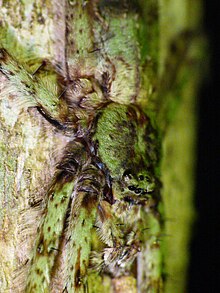Pandercetes
| Pandercetes | |
|---|---|

| |
| Pandercetes cf. celatus from the Western Ghats showing typical cryptic patterning | |
| Scientific classification | |
| Kingdom: | |
| Phylum: | |
| Class: | |
| Order: | |
| Suborder: | |
| Family: | |
| Genus: | Pandercetes L. Koch, 1875
|
| Species | |
|
see text | |
Pandercetes is a genus of spiders in the family Sparassidae, the huntsman spiders. They are mainly distributed in tropical Asia and Australia, and are known for their cryptic patterning that matches the moss and lichen on tree trunks where they are usually found.

Their legs have lateral hairs giving them a feathery appearance and break their outline. The head is somewhat elevated and the carapace has the thoracic region low and flat.[1] The genus is characterized by the internal anatomy of the reproductive structures. Males have irregular coils at the terminal end while females have screw like copulatory ducts.[2]
The genus was erected by Carl "Spider" Koch in his 1875 treatise on Australian spiders.[3]
Species
Species in the genus are found mostly in tropical forests in Asia and extending east to Australia.
- Pandercetes celatus Pocock, 1899[4]
- Pandercetes celebensis Merian, 1911
- Pandercetes celebensis vulcanicola Merian, 1911
- Pandercetes decipiens Pocock, 1899
- Pandercetes gracilis L. Koch, 1875 (type species)
- Pandercetes isopus Thorell, 1881
- Pandercetes longipes Thorell, 1881
- Pandercetes macilentus Thorell, 1895
- Pandercetes malleator Thorell, 1890
- Pandercetes manoius Roewer, 1938
- Pandercetes niger Merian, 1911
- Pandercetes nigrogularis (Simon, 1897)
- Pandercetes ochreus Hogg, 1922
- Pandercetes palliventris Strand, 1911
- Pandercetes peronianus (Walckenaer, 1837)
- Pandercetes plumipes (Doleschall, 1859)
- Pandercetes plumosus Pocock, 1899
References
- ^ Pocock, R.I. (1909). The Fauna of British India, including Ceylon and Burma. Arachnida. London: Taylor and Francis. pp. 259–265.
- ^ Jäger, Peter (2002). "Heteropodinae: Transfers and Synonymies (Arachnida: Araneae : Sparassidae)" (PDF). Acta Arachnologica. 51 (1): 33–61.
- ^ Koch, L. (1875). Die Arachniden Australiens. Volume 1 (PDF) (in German). pp. 577–740.
- ^ Pocock, R. I. (1899). "Diagnoses of some new Indian Arachnida". Journal of the Bombay Natural History Society. 12: 744–753.
